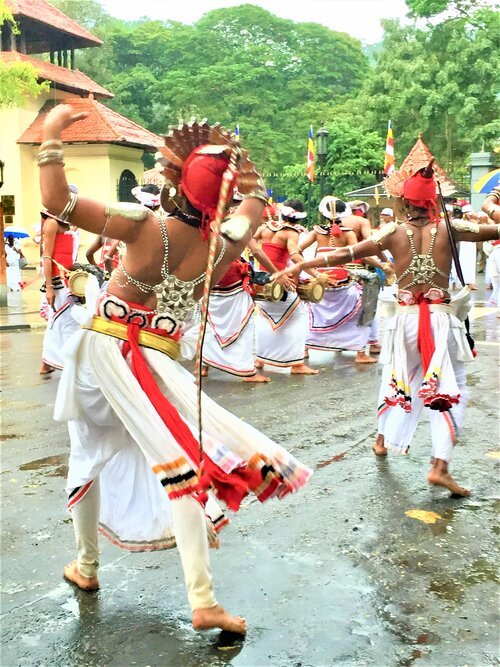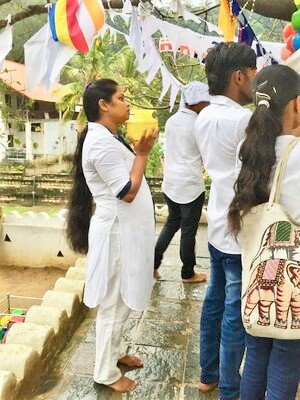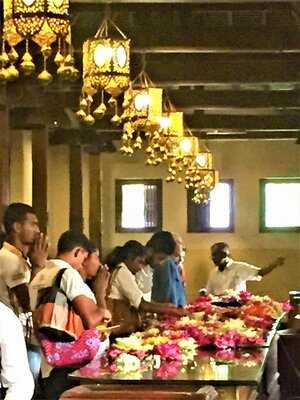vaga #5 /3 devotion
Part III
On the trip on the plane in which I arrived it was 85% full of monks returning from a conference, they told me, "if the plane crashes, I will go to Nirvana as part of the total package."
Sri Lanka, is where I have seen the most active popular religious expression of Theravada Buddhism which is 70%, not so with this effervescence I saw in Myanmar with 95% and half a million monks, here instead there are about 12 thousand monks. I go on to relate a holiday, a "Puya", the Puyas are the "full moon holidays" and it is incredible that each full moon is a national holiday, they follow the lunar calendar. It is a country where national holidays are extraordinary, I counted 25, now if you added, all the Sundays and Saturdays that only commerce works, it gives 129 days, that is, there are more than 4 months of holidays in a year. Doing any errands for what they have told me, you have to be patient, and you have to put it to the test at its best. There are also Muslim, Hindu and Christian holidays, such as "Good Friday", being that Christianity is minimal and all are national holidays.
I narrate the day of prayer for the "puja", in November in the city of Kandi, in the centre of the island, that "puja" that commemorates the ordination of sixty disciples of Buddha as the first missionaries of Buddhism. Both days it takes place in "Sri Dalada Maligawa" in the old royal palace next to the temple, very beautiful with many gardens and canals surrounding the palace next to the temple. Each "puja" represents some event in Buddhism, no alcohol is sold that day, nor the previous one anywhere including restaurants, it is so strict, that in my house in Kandi and without knowing the restrictions, I asked for a beer in the restaurant, They said no, then someone knocked on my door. One of the staff was carrying a beer wrapped in a shirt and told me to keep quiet and just have it in the room.
This happens outside the palace / temple, I have shown these photos previously for other reasons, they belong to this story, this “puja; dances, music, elephants with all the authorities of the city present. The elephant that carried the white display on his back formerly carried "the tooth of Buddha" relic that is kept in the temple, today it is the symbol, it is empty.
Thousands and thousands of pilgrims arrive and spend the whole day there, they have their picnics in the gardens, women strictly in white are even seen on the streets daily in white clothes, men in white shirts and trousers of one colour or older men wearing white sarongs.
the emperor Ashoka of India who came to the island 300 years before Christ implanted Buddhism. At the beginning of December, Sri Lanka celebrates the arrival of the 'Bodhi' tree in the ancient capital Anuradhapura, in the north. It was in the same type of 'Bodhi' tree that Buddha sat motionless and reached enlightenment, below. The first tree that arrived at the island is documented as the oldest tree in the world. There are many "Bodhi" throughout Buddhist Asia. Tributes are paid, they are cared for, prayed to and are always in temples and monasteries. Their respect is manifested in different ways wherever the tree is, each country has a preferred way of praising it from thin threads that surround the trunk, often old and faded, ribbons, flags, yellow umbrellas, niches in the contour with images of Buddha, some fenced in, others like in Thailand with sticks holding them as they call to sustain life. The last photo is not from Sri Lanka either, it is from Nepal, Kathmandu, the tree is in the middle of the chaotic city. They are very large, they are to be respected for their presence, healthy, robust, with perfect, green leaves, they are evergreens.
In the tree of the palace/temple of the puja one climbs up about twenty steps to a construction that surrounds it, there is an image of Buddha at the end of the stairs. The pilgrims go up, walk around it and deliver their offerings, one is holy water, they carry vases, make prayers and pour it in a specific place or small white rags where they write their requests and tie them on certain parts of the tree.
Another offering is fresh flowers, they are seen in huge piles, there are many mini temples scattered around the gardens with the image of Buddha and all with flowers. The flowers are chosen from a huge variety that they sell at the entrance, each person chooses and designs their colours and shapes, they take pains to choose the pretty ones, they are not corsages, the very refined result was remarkable, their colour, abundance of these with their aromas , suggest and have a feeling of harmony, beauty therefore something magical, spirituality recollection.
At 5 pm, the monks arrive, they settle in a booth on the esplanades with a microphone, there they give a long sermon, prayers that almost everyone participates in, they sit everywhere, they stop walking, nobody moves, there were hundreds and hundreds of believers, there are also offerings, practical things for the monks, such as rice, and utensils for the monastery, robes and the classic pots for food.
there are the prayers outdoors with the monks and those inside the temple, also in each niche.
Inside the temple is the "the tooth of Buddha", the tooth, arrived almost 2500 years ago and is cared for under 7 locks and keys, the enclosure is only opened once a year by the superior monks, nobody can see it, they pray in front of the place where it is kept.
Some of the hundreds of icons of the place, all different, ranging from high finesse in marble, and bronze, inside the temple and palace, to modern and cheap replicas in neon, outside. The use of neon in Sri Lanka for icons is overwhelming, they are large in the squares, streets, well-designed, they do not repeat themselves, at night it is like going through the streets of "nightclubs". All the houses, with constant recordings of mantras. The impact is so strong that Catholic images have also had to put neon on it to compete and not go unnoticed.
me and my curiosities as always, does the monk sleep or meditate? And what will be behind the curtain? Only in Sri Lanka do they use curtains and the mixtures of icons of Buddha with Ganesha interchangeably, they sometimes share temples.
The photos below are not of the puya I am uncertain here because it was extraordinary to see it, and it has to do with devotion. Returning from visiting a temple in a tuk tuk, it was already dark and going down a winding road from the hills that surround Kandi, I heard music and there was a party in the courtyard of a house, about 40 people, it was very dark, I asked the driver to stop . It was a ritual of that one of the faithful or two falls when possessed by a spirit, they dance, they contort themselves, they sing and the fire is the theme. The driver did not know what they were demonstrating, he was surprised, because he told me it was not common, nor did he engage in conversations with them since they were all dazzled, absorbed by the rite. The most pagan I have ever seen. They were Buddhist, it is the popular manifestations that give it their own interpretation or their need to manifest spontaneously, there are no icons here, nor flowers
It was another day not of "puya" for the sunset and the effervescence of the faithful is the same, many, at that time the candles and incenses started in specific places, they are in some types of glass "containers" so that the candles stay alight , they were three different containers three different places. A magical spectacle, they walk by and put their candles down all in silence, I felt devotion, recollection and a spirituality that did not leave one indifferent, it floats in the atmosphere, picks up the soul, without any reason, just feeling the spirit in silence. I took the time to take the photos, so they weren't crowded with parishioners.
I finish with this photo, and I am always turning to the idea of religion, symbols, devotion, which has surprised me so much and to think that my eyes and what they have seen in these times and how to understand it, I have so many contradictions on the subject, that I would like to one day put them in pencil and paper.










































































































